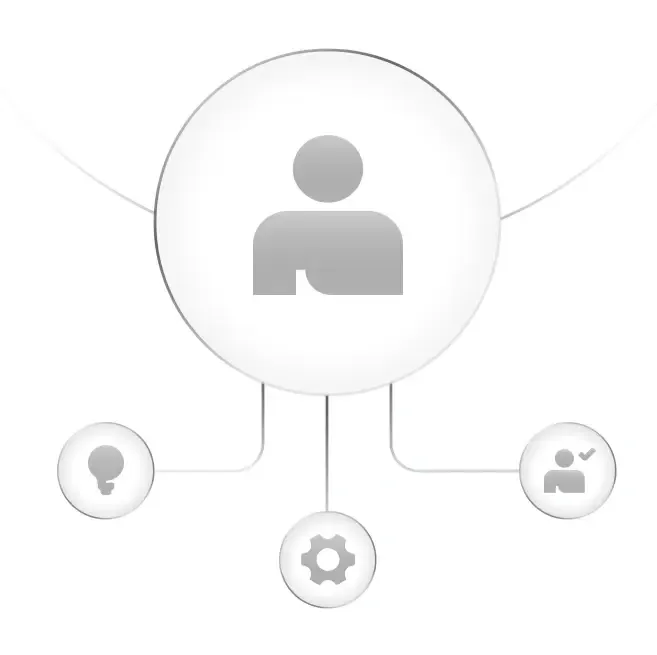Competency Framework & Skills Development Policy
Employee skills are the true engine of growth and innovation. That's why the competency framework policy ensures that the workforce is highly qualified and continuously improving. It establishes a structured approach for employee competency categories, levels, uses, review, and evaluation methods, supported by a model for a job competency framework.

Created by
Ahmed Abdel Wahab
|
Human Resources Adviser
Share the calculator with an HR college
What’s included in the competency framework policy?
The competency framework and skills development policy explains the different types of competencies required for both entry-level and leadership positions. It also clarifies the varying levels of competencies, from initial knowledge in a field to the ability to lead and innovate within it.
Since periodic performance reviews are essential for skill development, the policy addresses various performance evaluation methods designed to achieve a comprehensive, multifaceted measurement of employee performance.
It also discusses the relationship between job descriptions and job competencies, including their categories and different levels.
The policy also answers a crucial question: How can the rich data from competencies be utilized across various work areas within the company?
Finally, the competency policy and procedure defines the responsibilities placed on Human Resources management, managers, and employees themselves concerning performance evaluation and development processes.
Competency Framework Policy - Table of contents
1. Overview
2. Objectives
3. Competency Categories
4. Competency Levels
5. Assessment Tools
6. Integration with Job Description
7. Competency Applications
8. Competency Review Cycle
9. Governance & Responsibility
10. Regulatory Compliance
11. Competency Framework Template
Why do you need a competency framework policy?
Promoting overall success by aligning individual skills with long-term objectives.
To provide clear performance expectations for both employees and managers.
A framework for developing skills and refining the capabilities and potential of the workforce.
To enhance work efficiency by ensuring employees possess the appropriate skills.
How do you use the model?
Download the template and review the content.
Customize it with name, logo, job structure and performance evaluation methods.
Share it with the Human Resources department and department managers.
Ensure compliance by getting Competency Framework & Skills Development policy reviewed by a legal/HR expert.
See Jisr in action
Scale HR operations, manage talent, control spend – all in one platform with Jisr. Get started in weeks, not months.

FAQs
Building a competency framework involves outlining the essential knowledge, skills, and behaviors needed for success in various roles. Here's how to approach it:
- Identify Competencies: Analyze job descriptions, conduct interviews with employees and subject matter experts, and review industry standards to pinpoint the critical skills and behaviors required.
- Define Competencies and Levels: Create clear descriptions for each competency with observable behaviors. Establish proficiency levels (e.g., basic, intermediate, advanced) to show progression and provide examples for clarity.
- Integrate into HR Processes: Link the framework to job descriptions, performance management systems for feedback and development, recruitment for candidate screening, and training programs to address skill gaps.
- Communicate and Review: Ensure the framework is accessible and understood by all. Explain its benefits and regularly review and update it to keep it relevant with evolving business needs.
To create an effective skills development plan, HR can guide employees through these steps:
- Outline Ambitions: Encourage employees to define their long and short-term career goals, as these will direct which skills are most relevant to develop.
- Assess Strengths and Weaknesses: Prompt employees to honestly evaluate their current skills, perhaps using a SWOT analysis, to identify areas needing improvement and potential opportunities.
- Create a Development Strategy: Help employees formulate specific, measurable, achievable, relevant, and timely (SMART) actions to turn weaknesses into strengths, like seeking mentorship or targeted training.
HR often prioritizes professional skills development across three key areas:
- Functional Skills: These are the technical abilities essential for performing a specific job. For instance, a web developer needs coding languages.
- Self-Management Skills: These abilities help individuals manage themselves professionally and personally, including time management, stress management, and conflict resolution.
- Special Knowledge Skills: These unique, often harder-to-acquire skills provide a significant competitive advantage. Examples include fluency in multiple languages, deep industry knowledge, or rare expertise, making employees uniquely valuable.
Focusing on weaker areas within these categories can lead to more career opportunities.
Developing leadership skills is an ongoing journey that combines self-awareness, skill refinement, and practical application. It begins with self-assessment and goal setting to pinpoint strengths and weaknesses, allowing you to set clear objectives.
Key areas for skill development include mastering communication, effective delegation, sharp decision-making, and constructive conflict resolution, alongside cultivating emotional intelligence.
To gain experience, actively seek leadership opportunities, embrace feedback from peers and superiors, and learn from mentors. Continuous learning through books, workshops, and courses is also vital. Ultimately, strong leaders embody mindsets like adaptability, resilience, integrity, and a clear vision to inspire their teams.
Give me some professional development skills examples.
- Professional development skills are abilities that enhance a person's career. Here are some examples:
Communication Skills: This includes abilities like active listening to understand others' perspectives, clear verbal communication for presentations, and effective written communication for reports and emails.
Leadership Skills: Examples are strategic thinking to align with company goals, delegation to empower others, and conflict resolution to address disagreements constructively.
Problem-Solving Skills: This category includes critical thinking to analyze information, decision-making based on sound judgment, and adaptability to handle new challenges with flexibility.